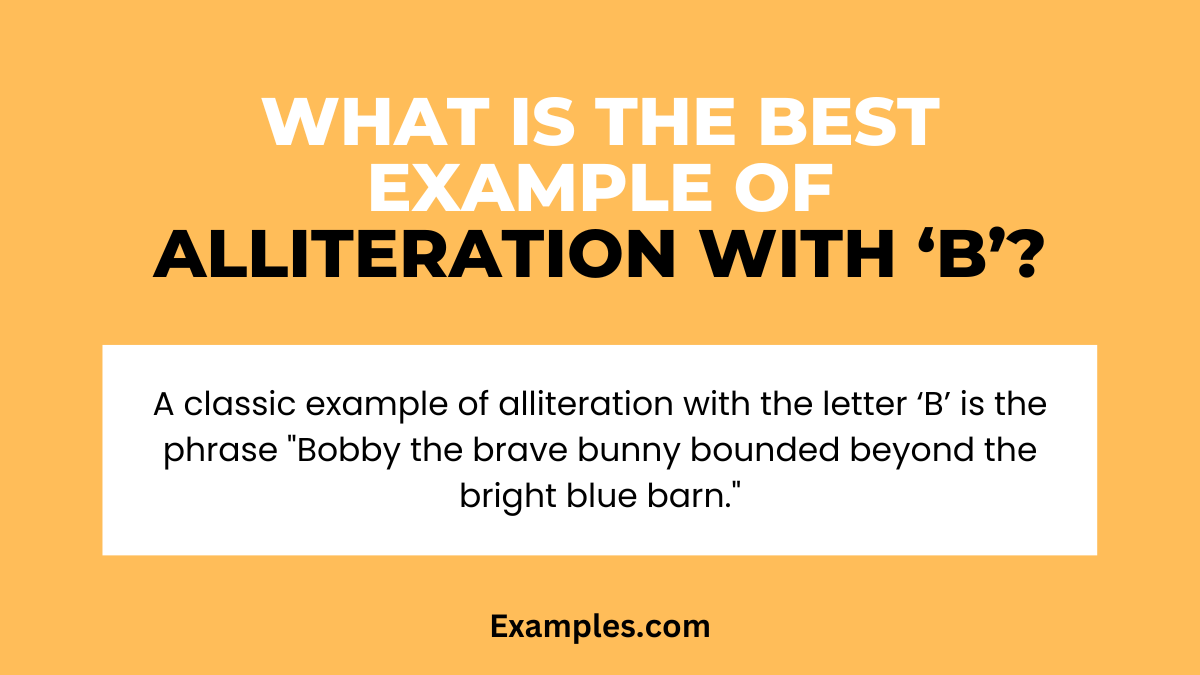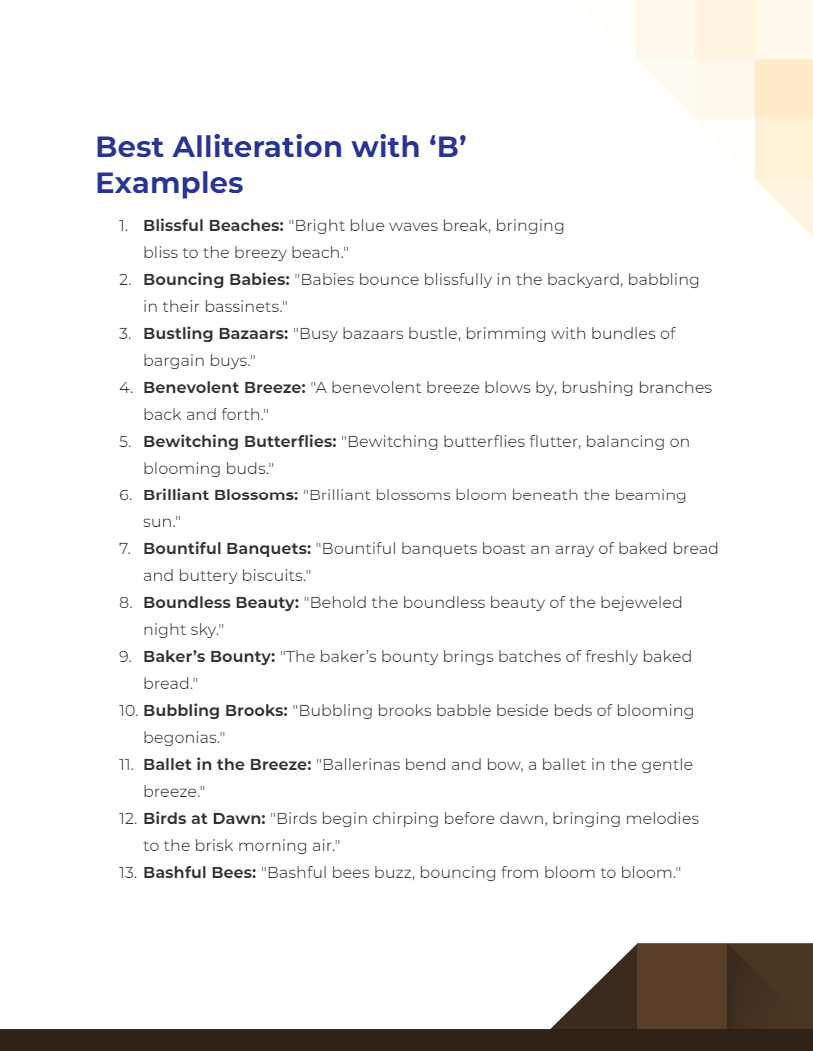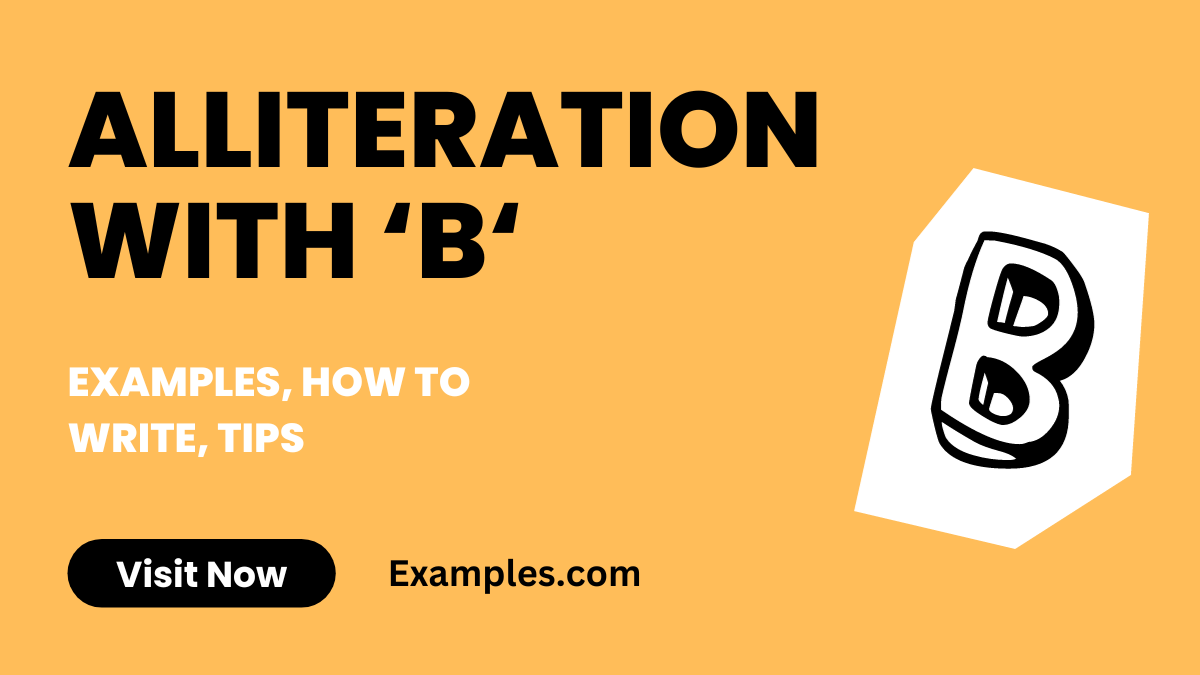12+ Alliteration with B Examples
Alliteration, a powerful literary tool, involves the repetition of the same consonant sound at the beginning of adjacent or closely connected words. When it comes to alliteration with the letter ‘B,’ the technique creates a specific auditory effect, enhancing the textual rhythm and mood. Writers often use this form of alliteration to add a lyrical quality to their prose or poetry, making the content more memorable and engaging. It’s particularly effective in poetry, tongue twisters, and persuasive writing, where rhythm and sound play a significant role in the impact of the words. Whether in literary works, marketing material, or everyday language, ‘B’ alliterations and assonance bring a unique beat and bounce to sentences, captivating readers and listeners alike.
Download Best Alliteration with 'B' Examples
Download Alliteration with 'A' to 'Z' Examples
What is the Best Example of Alliteration with ‘B’?

Example: A classic example of alliteration with the letter ‘B’ is the phrase “Bobby the brave bunny bounded beyond the bright blue barn.”
Meaning: In this easy alliteration example, the repetition of the ‘b’ sound at the beginning of multiple words creates a melodious and rhythmic quality to the sentence. The words “Bobby,” “brave,” “bunny,” “bounded,” “beyond,” “bright,” and “blue” all start with the ‘b’ sound. This not only adds a poetic and musical element to the sentence but also makes it memorable and engaging for the reader. But Hard Alliteration with ‘B’ is a powerful literary device often used to create vivid imagery and evoke emotions in writing.
20 Alliteration with ‘B’ Examples

Download Alliteration with 'B' Examples in PDF
Alliteration in Rhymes, the repetition of consonant sounds at the beginning of words, is a poetic device that adds rhythm and musicality to language. When focusing on the letter ‘B’, this technique brings a bold, bouncy, or sometimes soothing quality to sentences. Here are 20 unique examples of alliteration with ‘B’, each accompanied by a creative title to encapsulate the essence of the rhythm.
- Blissful Beaches “Bright blue waves break, bringing bliss to the breezy beach.”
- Bouncing Babies “Babies bounce blissfully in the backyard, babbling in their bassinets.”
- Bustling Bazaars “Busy bazaars bustle, brimming with bundles of bargain buys.”
- Benevolent Breeze “A benevolent breeze blows by, brushing branches back and forth.”
- Bewitching Butterflies “Bewitching butterflies flutter, balancing on blooming buds.”
- Brilliant Blossoms “Brilliant blossoms bloom beneath the beaming sun.”
- Bountiful Banquets “Bountiful banquets boast an array of baked bread and buttery biscuits.”
- Boundless Beauty “Behold the boundless beauty of the bejeweled night sky.”
- Baker’s Bounty “The baker’s bounty brings batches of freshly baked bread.”
- Bubbling Brooks “Bubbling brooks babble beside beds of blooming begonias.”
- Ballet in the Breeze “Ballerinas bend and bow, a ballet in the gentle breeze.”
- Birds at Dawn “Birds begin chirping before dawn, bringing melodies to the brisk morning air.”
- Bashful Bees “Bashful bees buzz, bouncing from bloom to bloom.”
- Boisterous Banter “Boisterous banter breaks out in the bustling cafeteria.”
- Breezy Balcony “Breezes blow across the balcony, bringing scents of blooming basil.”
- Brave Buccaneers “Brave buccaneers sail the blue sea, braving the bellowing winds.”
- Bewildered by Beauty “Bewildered by beauty, he beheld the blossoming garden.”
- Bells in the Belfry “Bells bellow in the belfry, broadcasting their boisterous clang.”
- Bounteous Bananas “Bounteous bananas hang beneath broad, leafy branches.”
- Bookworm’s Bliss “Bookworms bask in blissful silence, buried in their beloved books.”
Alliteration Sentence Examples with ‘B’
Blending ‘B’ sounds in alliteration sentences brings a rhythmic bounce, perfect for emphasizing key points or injecting a playful tone. Here are three unique examples:
- “Bobby’s baseball bounced beyond the backyard boundary.”
- “Barbara baked brownies for Billy’s birthday bash.”
- “Benny’s big brown bear bravely bounded over boulders.”
Alliteration Examples with ‘B’ Words
Using words that start with ‘B’ creates alliteration that can add a whimsical or bold flavor to writing. Here are three distinctive examples:
- “Bubbles, balloons, and butterflies beautify the birthday party.”
- “Brisk breezes blow, bending the tall bamboo gracefully.”
- “Bright, burning bonfires blaze on the beach at night.”
Alliteration Examples with ‘B’ Name
Names beginning with ‘B’ can be part of alliterative phrases, ideal for character names in stories or creative writing. Three unique examples are:
- “Bella’s blue bicycle broke down before the bridge.”
- “Benjamin bought a big, bright, blue backpack.”
- “Brianna’s brilliant baking brought joy to the family.”
Alliteration Examples with ‘B’ Sound
The ‘B’ sound, when repeated, can add a memorable, musical quality to phrases. Here are three creative examples:
- “Becky’s birds chirp before breakfast, bantering melodiously.”
- “Booming beats bring life to the quiet basement.”
- “Brenda’s baby babbles blissfully in her crib.”
Alliteration Examples with ‘B’ Adjectives
Incorporating ‘B’ adjectives in alliteration adds descriptive depth to sentences. Here are three vivid examples:
- “The brave, bold bear ventured into the unknown woods.”
- “Bitter, biting winds swept across the barren land.”
- “Bright, blooming flowers adorned the lush, green backyard.”
Alliteration Phrases with ‘B’
Alliteration phrases with ‘B’ effortlessly blend the buoyant and bold sound of ‘B’ to create memorable and musical lines. These phrases can be whimsically whimsical or beautifully profound, setting the tone for various writing styles. Here are three unique examples:
- “Bountiful berries beckon beneath the bright morning sun.”
- “Booming bass beats build in the bustling nightclub.”
- “Brilliantly bound books beckon from the bookstore’s shelves.”
Alliteration Poem with ‘B’
Poems using alliteration with ‘B’ often exhibit a rhythmic beauty, with the repetition of the ‘B’ sound providing a pleasing auditory experience. The letter ‘B’ lends itself to vivid, bold imagery, enhancing the poem’s appeal. Here are three unique alliteration poems with ‘B’:
- “Beneath the bright moon, birds bid goodbye, / Their songs blend in the black sky, / Bringing peace as the night breezes by.”
- “Bouncing balls in the backyard, / Boys and girls play without guard, / Blissful laughter, life’s reward.”
- “Barefoot by the babbling brook, / A boy with a book, in a cozy nook, / Lost in stories, no need to look.”
How to Write Alliteration with ‘B’?
Writing alliteration answers with the letter ‘B’ involves creating phrases or sentences where several words start with the ‘B’ sound. This technique adds a rhythmic, poetic quality to writing. Here’s how to craft effective alliteration with ‘B’:
- Understand the ‘B’ Sound: The ‘B’ sound is a plosive consonant, producing a bold and pronounced effect. Familiarize yourself with the sound to use it effectively.
- Choose Your Theme: Decide on the theme or subject of your sentence or piece. This helps in selecting appropriate ‘B’ words that are relevant and meaningful.
- Brainstorm ‘B’ Words: List words starting with the ‘B’ sound. Consider using a thesaurus for more options. Focus on words that fit your theme and create the desired mood.
- Create a Rhythmic Structure: Arrange the ‘B’ words to form a rhythm. Alliteration is not just about repetition; it’s about creating a musical flow in your writing.
- Craft Your Phrase or Sentence: Combine your chosen ‘B’ words into a phrase or sentence. Ensure that it makes sense and contributes to your overall message or story.
- Read Aloud: Test the effectiveness of your alliteration by reading it aloud. This helps check the rhythm and the impact of the alliteration.
- Revise for Clarity and Impact: Edit your sentence to ensure clarity. Sometimes, less is more. Strive for a balance between alliteration and overall meaning.
- Incorporate Into Your Writing: Once satisfied, integrate your alliterative phrase into your larger text, enhancing its lyrical quality and memorability.
Tips for Using Alliteration with ‘B’
- Use Sparingly: Overuse of alliteration can overwhelm the reader. Use it judiciously to highlight important points or to add flair.
- Maintain Clarity: While alliteration adds style, clarity should always be your priority. Ensure your sentence remains clear and easy to understand.
- Vary Word Lengths: Mix short and long words for a more interesting and varied rhythm. This prevents monotony in your alliteration.
- Consider the Context: Tailor your alliteration to suit the context and tone of your writing. In a formal document, subtle alliteration can be more effective.
- Focus on Flow: Ensure the alliterative words flow naturally within your sentence. Forced alliteration can detract from the reading experience.
- Emphasize Emotions and Themes: Use alliteration to reinforce the emotions or themes in your writing. ‘B’ words can convey a range of feelings from joy to solemnity.
- Experiment with Forms: Try using alliteration in different types of writing — from creative to academic — to see how it can enhance your work.
By following these guidelines, you can effectively use alliteration with ‘B’ to add a memorable and rhythmic quality to your writing, making it more engaging and enjoyable for your audience.
What is the Sound Effect of ‘B’ Letter in Alliteration?
The sound effect of the letter ‘B’ in alliteration is quite distinctive and impactful. This plosive consonant produces a sharp, abrupt sound that can lend a sense of boldness, briskness, or impact to a phrase. The ‘B’ sound is forceful yet versatile, often used to convey a range of emotions and imagery, from the gentleness of “bubbles” to the intensity of “blaze.” In alliteration songs, the repetition of the ‘B’ sound creates a rhythmic beat, which can make the text more memorable and engaging for the reader or listener. This sound effect is particularly effective in poetry, advertising, and prose to draw attention, evoke specific feelings, or create a mood.
What are the Repetition of ‘B’ Words in Alliteration?
In alliteration figurative language, the repetition of ‘B’ words involves using multiple words that begin with the ‘B’ sound in close proximity. This technique creates a rhythm and a sonic pattern, enhancing the linguistic appeal of a sentence or phrase. The repetition of ‘B’ words is not just about the sound; it’s also about the thematic connection among these words. Writers often use this method to emphasize a point, create mood, or simply add a lyrical quality to their writing. For example, “The baby birds basked in the bright morning sun,” not only repeats the ‘B’ sound but also paints a vivid picture in the reader’s mind.
What is the Alliteration ‘B’ Type of?
Alliteration with the letter ‘B’ falls under the category of consonant alliteration, where the repeated sound is a consonant, in this case, the ‘B’ sound. This type of great alliteration is characterized by the repetition of the same consonant sound at the beginning of adjacent or closely connected words. It’s one of the most common and effective forms of alliteration, used across various forms of writing. The ‘B’ type of alliteration is especially notable for its ability to produce a rhythmic and often bold sonic effect, making it a favorite among poets and authors.
How Many Words Start with ‘B’ in Alliteration?
The number of words that can start with ‘B’ in an alliterative phrase or sentence is not fixed and varies depending on the context and the writer’s intention. However, for effective famous alliteration, it is generally recommended to have at least two or three ‘B’ words in close succession. Too few may not create the desired rhythmic effect, while too many can make the text seem forced or overly repetitive. The key is to strike a balance, ensuring the alliteration enhances the text without overpowering it. The choice of how many ‘B’ words to use also depends on factors like the length of the phrase, the overall style of the piece, and the specific effect the writer is trying to achieve.


